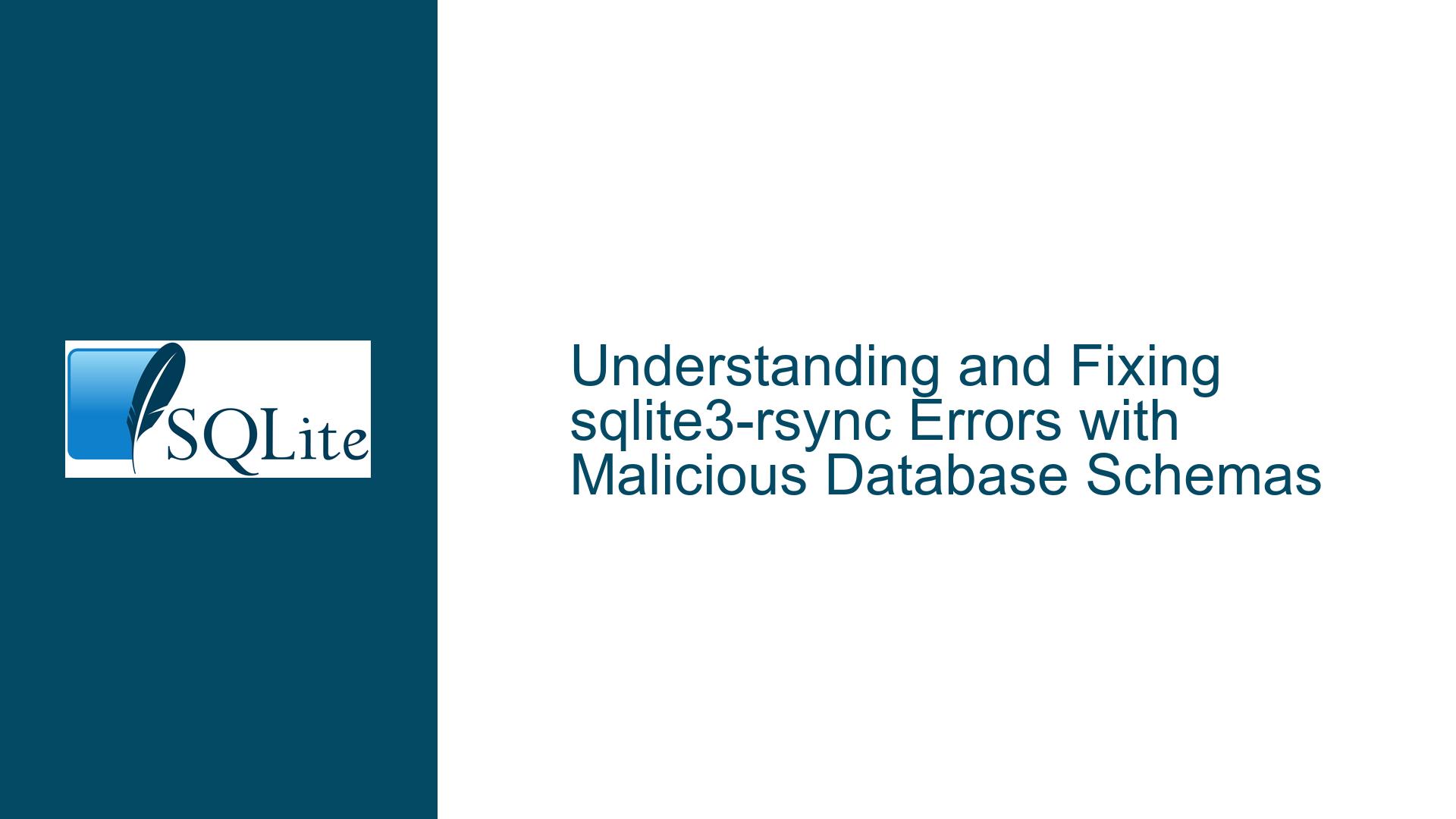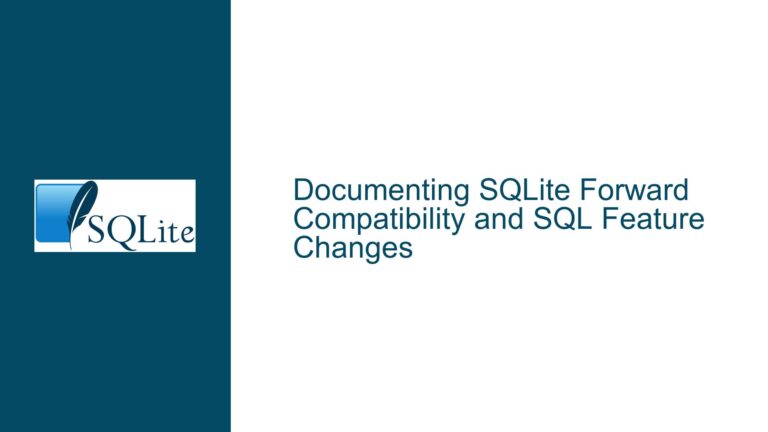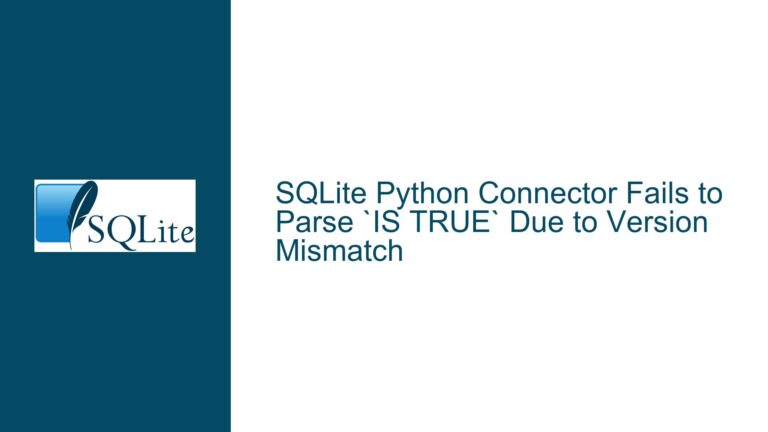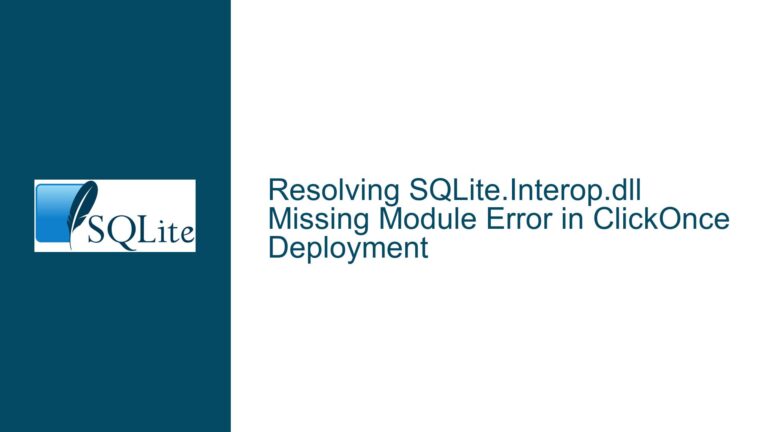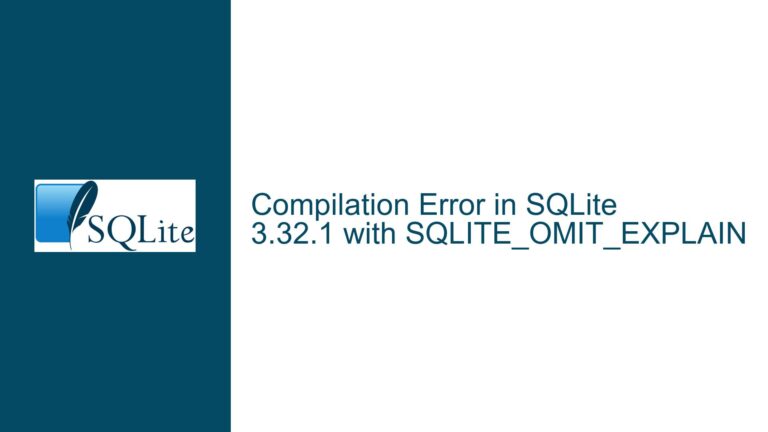and Fixing sqlite3-rsync Errors with Malicious Database Schemas
Issue Overview: sqlite3-rsync Fails Due to Misconfigured Database Schema
The core issue revolves around the behavior of sqlite3-rsync when interacting with a database that has been intentionally or unintentionally misconfigured. Specifically, the problem arises when the database schema is altered in a way that replaces a critical function (sqlite_dbpage) with a table of the same name. This misconfiguration causes sqlite3-rsync to fail during its operation, as it expects sqlite_dbpage to be a function but encounters a table instead.
The misconfiguration is achieved through a series of SQL commands that disable defensive settings, enable schema modifications, and create a table named sqlite_dbpage. This table replaces the expected function, leading to a runtime error when sqlite3-rsync attempts to use it. The error message explicitly states that sqlite_dbpage is not a function, which halts the synchronization process.
This issue highlights a critical vulnerability in sqlite3-rsync when dealing with databases that have been tampered with or are otherwise maliciously constructed. The tool assumes a certain schema integrity, and when that assumption is violated, it fails to handle the situation gracefully. Understanding the root causes and potential fixes for this issue is essential for developers and database administrators who rely on sqlite3-rsync for database synchronization.
Possible Causes: Schema Tampering and Defensive Configuration Disabling
The root cause of the issue lies in the deliberate tampering with the database schema, which is facilitated by disabling SQLite’s defensive configurations. The sequence of commands provided in the example demonstrates how a malicious actor or a misconfigured script can alter the database schema in a way that breaks sqlite3-rsync.
The first command, .dbconfig defensive off, disables SQLite’s defensive mechanisms. These mechanisms are designed to prevent certain dangerous operations, such as modifying the schema in ways that could corrupt the database or introduce security vulnerabilities. By turning off these defenses, the subsequent commands are able to execute without the usual safeguards.
The second command, pragma writable_schema='on', enables write access to the SQLite schema. Normally, the schema is read-only, preventing unauthorized modifications. However, with this pragma enabled, the schema can be altered directly, including the creation or modification of system tables and functions.
The third command, create table sqlite_dbpage (id integer primary key), creates a table named sqlite_dbpage. This table name conflicts with the expected function name used by sqlite3-rsync. The function sqlite_dbpage is typically used by sqlite3-rsync to access and compare database pages during the synchronization process. By replacing this function with a table, the tool is unable to perform its intended operations.
The fourth command, pragma writable_schema='reset', resets the schema write access to its default state. This step is likely taken to conceal the tampering, making it less obvious that the schema has been modified.
The final command, pragma journal_mode='wal', sets the journal mode to Write-Ahead Logging (WAL). While this command is not directly related to the issue, it is often used to improve database performance and concurrency. However, in this context, it serves as a distraction, making the malicious changes less noticeable.
The combination of these commands results in a database that is structurally valid but functionally compromised. When sqlite3-rsync attempts to synchronize such a database, it encounters the unexpected table sqlite_dbpage instead of the expected function, leading to the observed error.
Troubleshooting Steps, Solutions & Fixes: Addressing Schema Tampering and Enhancing sqlite3-rsync Resilience
To address this issue, a multi-faceted approach is required. This includes both immediate troubleshooting steps to resolve the error and long-term solutions to enhance the resilience of sqlite3-rsync against similar schema tampering.
Immediate Troubleshooting Steps
The first step in troubleshooting this issue is to identify and reverse the schema tampering. This can be done by examining the database schema and restoring the expected function sqlite_dbpage. The following SQL commands can be used to inspect the schema and identify any unauthorized modifications:
SELECT * FROM sqlite_master WHERE type = 'table' AND name = 'sqlite_dbpage';
This query will return information about the sqlite_dbpage table, if it exists. If the table is found, it should be dropped to remove the conflict:
DROP TABLE sqlite_dbpage;
After removing the conflicting table, the expected function sqlite_dbpage should be restored. This function is typically provided by SQLite or the sqlite3-rsync tool itself. If the function is missing, it may need to be recreated or reinstalled.
Once the schema has been restored, the defensive configurations should be re-enabled to prevent further tampering:
.dbconfig defensive on
pragma writable_schema='off';
These commands re-enable SQLite’s defensive mechanisms and disable schema write access, ensuring that the schema cannot be easily modified in the future.
Long-Term Solutions
To prevent similar issues from occurring in the future, several long-term solutions can be implemented. These solutions focus on enhancing the resilience of sqlite3-rsync and improving the overall security of the database.
1. Schema Validation: Before performing any synchronization operations, sqlite3-rsync should validate the database schema to ensure that it meets the expected structure. This validation should include checks for the presence of critical functions like sqlite_dbpage and the absence of conflicting tables or other schema elements. If any discrepancies are found, the tool should either abort the operation or attempt to repair the schema automatically.
2. Defensive Configuration Enforcement: sqlite3-rsync should enforce defensive configurations on the databases it interacts with. This includes enabling defensive mechanisms and disabling schema write access before performing any operations. These configurations should be enforced regardless of the current state of the database, ensuring that the tool operates in a secure environment.
3. Error Handling and Recovery: The tool should be enhanced to handle errors more gracefully. When an unexpected schema element is encountered, the tool should attempt to recover by identifying and resolving the issue, rather than simply aborting the operation. This could involve logging the error, notifying the user, and providing options for manual intervention.
4. User Education and Documentation: Users of sqlite3-rsync should be educated about the importance of maintaining a secure and consistent database schema. Documentation should be provided that outlines best practices for schema management and the potential risks of disabling defensive configurations. This education can help prevent unintentional schema tampering and reduce the likelihood of similar issues occurring in the future.
5. Regular Audits and Monitoring: Regular audits of the database schema should be conducted to identify and address any unauthorized modifications. Monitoring tools can be used to track changes to the schema and alert administrators to any suspicious activity. These audits and monitoring efforts can help detect and resolve issues before they impact the synchronization process.
By implementing these solutions, the resilience of sqlite3-rsync can be significantly improved, reducing the risk of errors caused by schema tampering and ensuring that the tool operates reliably in a variety of environments.
In conclusion, the issue with sqlite3-rsync failing due to a misconfigured database schema highlights the importance of maintaining schema integrity and enforcing defensive configurations. By understanding the root causes of the issue and implementing both immediate troubleshooting steps and long-term solutions, developers and database administrators can ensure that sqlite3-rsync operates reliably and securely. This comprehensive approach not only resolves the current issue but also prevents similar problems from arising in the future, enhancing the overall robustness of the database synchronization process.
